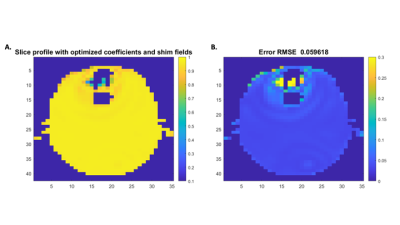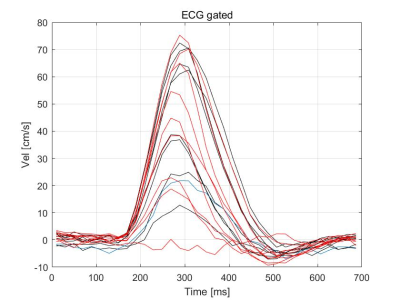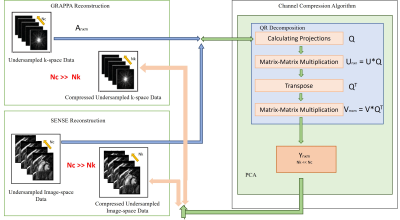Digital Poster
Advanced Acquisition Techniques
ISMRM & ISMRT Annual Meeting & Exhibition • 03-08 June 2023 • Toronto, ON, Canada

| Computer # | |||
|---|---|---|---|
2372. |
21 | B1+ inhomogeneity mitigation in slice-selective excitation at 7T with a single-channel RF coil augmented by ΔB0 shim array fields
Molin Zhang1, Georgy Guryev1, Nick Arango1, Jason Stockmann2,3, Jacob White1, and Elfar Adalsteinsson1,4,5
1EECS, MIT, Cambridge, MA, United States, 2Athinoula A. Martinos Center for Biomedical Imaging, Charlestown, MA, United States, 3Department of Radiology, Harvard Medical School, Charlestown, MA, United States, 4Harvard-MIT Health Sciences and Technology, MIT, Cambridge, MA, United States, 55 Institute for Medical Engineering and Science, MIT, Cambridge, MA, United States Keywords: Pulse Sequence Design, RF Pulse Design & Fields We explored the utility of shim array fields in the mitigation of in-plane B1+ inhomogeneity for a slice-selective excitation at 7T and achieved better magnitude of transverse magnetization compared with birdcage transmit using conventional single-channel RF excitation. Approximately 2:1 range of B1+ was mitigated, at the cost of increased peak RF power, shim array current demands up to 20 A, and minor out-of-slice sidelobes. |
|
2373. |
22 | Echo-Volume Imaging with Restricted Field-of-View and (k, t)-Space Undersampling: A Fast fMRI Acquisition Technique
Qingfei Luo1, Kaibao Sun1, Guangyu Dan1,2, Muge Karaman1,2, and Xiaohong Joe Zhou1,2,3
1Center for Magnetic Resonance Research, University of Illinois at Chicago, Chicago, IL, United States, 2Department of Biomedical Engineering, University of Illinois at Chicago, Chicago, IL, United States, 3Departments of Radiology and Neurosurgery, University of Illinois at Chicago, Chicago, IL, United States Keywords: Pulse Sequence Design, fMRI Echo-volume imaging (EVI) can offer higher acquisition speed than echo-planar imaging (EPI) but is more sensitive to image distortion and blurring. In this study, we develop an EVI-based fast fMRI acquisition technique by employing three-dimension restricted field-of-view imaging (k-t rFOV-EVI) and (k, t)-space undersampling. Our human fMRI experiments covering the visual cortex demonstrate that k-t rFOV-EVI can provide higher image quality and fMRI detection sensitivity than the simultaneous multi-slice EPI at 2.5-mm-isotropic spatial resolution with a temporal resolution of 240 ms. |
|
2374. |
23 | Asymmetric echo variable flip angle RARE for n-echo Dixon based PDFF @ 9.4T
Wan-Ting Zhao1, Karl-Heinz Herrmann1, Renat Sibgatulin1, Janine Arlt2, Weiwei Wei2, Uta Dahmen2, and Jürgen R. Reichenbach1
1Medical Physics Group, Institute of Diagnostic Radiology, University hospital Jena, Jena, Germany, 2Experimental Transplantation Surgery, Department of General, Visceral and Vascular Surgery, University hospital Jena, Jena, Germany Keywords: Pulse Sequence Design, Preclinical This work demonstrates the use of echo-shifting in combination with an efficient variable flip angle 3D RARE to reconstruct fat fraction distribution in a liver sample, resolving the fine structure of the fat deposits in the tissue with a Dixon based analysis at 9.4T. |
|
2375. |
24 | Tailored multi-dimensional partial saturation pulses for inner/outer-volume spoiled steady-state imaging
Jon-Fredrik Nielsen1 and Kawin Setsompop2,3
1fMRI Laboratory and Biomedical Engineering, University Of Michigan, Ann Arbor, MI, United States, 2Radiology, Stanford University, Palo Alto, CA, United States, 3Electrical Engineering, Stanford University, Palo Alto, CA, United States Keywords: Pulse Sequence Design, RF Pulse Design & Fields We propose to use short (~1–1.5ms) multi-dimensional spatially selective RF pulses that saturate unwanted signal regions in spoiled gradient echo (SPGR/FLASH/T1-FFE) imaging. These pulses can be inserted at regular intervals in the sequence, e.g., immediately before each imaging excitation pulse. By reducing signal contamination from outside the region of interest (ROI), these pulses should enable more rapid and robust T1- and T2*-weighted imaging in many body and neuro applications. |
|
2376. |
25 | Tracking Abdominal Organ Motion in Real-time T2-weighted MRI with 2 Simultaneously Acquired Orthogonal Slices
Samantha Hickey1, Andreas Reichert1, Lars Bielak1,2, Wolfgang Ptacek3, Thomas Bortfeld4, and Michael Bock1
1Division of Medical Physics, Dept. of Diagnostic and Interventional Radiology, University Medical Center Freiburg, Faculty of Medicine, University of Freiburg, Freiburg, Germany, 2German Cancer Consortium (DKTK), Partner Site Freiburg, Freiburg, Germany, 3ACMIT Gmbh, Wiener Neustadt, Austria, 4Division of Radiation Biophysics, Department of Radiation Oncology, Massachusetts General Hospital and Harvard Medical School, Boston, MA, United States Keywords: Pulse Sequence Design, Radiotherapy, Interventional, T2-weighted Radiotherapy, cryoablation, and percutaneous needle biopsy procedures profit from MR-guidance with real-time lesion tracking. T2-weighted images often provide superior lesion contrast, but the temporal resolution of conventional T2-weighted sequences is insufficient for real-time MRI. Here, we present a fast, T2-weighted sequence Ortho-SSFP-Echo, which simultaneously acquires two orthogonal images, to track breathing induced kidney motion. |
|
2377. |
26 | Fast Magnetization-Prepared Gradient Echo Sequences for 3D-T1rho Mapping of the Knee Joint Using Optimized Variable Flip-Angles
Marcelo V. W. Zibetti1, Hector L. De Moura1, Mahesh B. Keerthivasan2, and Ravinder R. Regatte1
1Radiology, NYU Grossman School of Medicine, New York, NY, United States, 2Siemens Medical Solutions, Malvern, PA, United States Keywords: Pulse Sequence Design, Quantitative Imaging We proposed an efficient magnetization-prepared gradient echo (MP-GRE) sequence that uses optimized variable flip-angles (OVFA) to reduce acquisition time by 4x while increasing SNR when compared to magnetization-prepared angle-modulated partitioned k-space spoiled GRE snapshots (MAPSS), typically used for T1rho mapping. The proposed OVFA based sequence can improve the spatial resolution of T1rho mapping by 4x, with nearly same SNR and scan time as MAPSS. |
|
2378. |
27 | WHIRLED PEAS: Analytical Equations for Spiral Trajectories and Matching Gradient Waveforms
James G Pipe1
1Radiology, Mayo Clinic, Rochester, MN, United States Keywords: Pulse Sequence Design, New Trajectories & Spatial Encoding Methods, Spiral, WHIRL, analytical This work introduces exact time-dependent analytical solutions, for both gradient waveforms and k-space trajectories, for an optimized spiral-based imaging strategy based on maximum frequency, perpendicular slew rate, and gradient magnitude constraints. |
|
2379. |
28 | View ordering in PROPELLER for MSK applications
Henric Rydén1, Adam van Niekerk1, Matea Borbas2, and Mikael Skorpil3
1Clinical Neuroscience, Karolinska Institutet, Stockholm, Sweden, 2Karolinska University Hospital, Stockholm, Sweden, 3Karolinska Institutet, Stockholm, Sweden Keywords: Pulse Sequence Design, Data Acquisition, FSE, RARE, PROPELLER A novel view ordering scheme for RARE (FSE/PROPELLER) imaging is proposed and compared with the vendor solution, particularly suited for MSK applications where intermediate TE is desired. |
|
2380. |
29 | DeepRF for simulatneous multislice pulses
Jiye Kim1, Hongjun An1, Chungseok Oh1, Berkin Bilgic2,3, and Jongho Lee1
1Department of Electrical and Computer Engineering, Seoul National University, Seoul, Korea, Republic of, 2Department of Radiology, Havard Medical School, Boston, MA, United States, 3Athinoula A. Martinos Center for Biomedical Imaging, Charlestown, MA, United States Keywords: Pulse Sequence Design, Machine Learning/Artificial Intelligence DeepRF1 is a recently proposed RF pulse design method2-5 using deep reinforcement learning and optimization, generating an RF pulse defined by a reward (e.g., slice profile and energy constraint) from self-learning. Here, we proposed an improved algorithm for DeepRF that incorporates a modulation function to design an simultaneous multislice6 RF pulse. The new algorithm is tested and compared with the original multiband9 pulses, reporting reduced RF energy while preserving the characteristics of the original slice profile. Additionally, a multiPINS8 like inversion pulse is designed to demonstrate the usefulness of DeepRF for a non-constant slice selective gradient.
|
|
2381. |
30 | Variable-Density Velocity-Selective Preparation for Non-Contrast-Enhnaced MR Angiography
Minyoung Kim1,2, Jaeseok Park3,4, Seunghong Choi5, and Taehoon Shin1,2
1Department of Mechanical and Biomedical Engineering, Ewha Womans University, Seoul, Korea, Republic of, 2Graduate Program in Smart Factory, Ewha Womans University, Seoul, Korea, Republic of, 3Department of Biomedical Engineering, Sungkyunkwan University, Suwon, Korea, Republic of, 4Department of Intelligent Precision Healthcare Convergence, Sungkyunkwan University, Suwon, Korea, Republic of, 5Department of Radiology, Seoul National University Hospital, Seoul National University College of Medicine, Seoul, Korea, Republic of Keywords: Pulse Sequence Design, Pulse Sequence Design, Variable Density Sampling Excitation Velocity-selective (VS) magnetization preparation has shown great promise for non-contrast-enhanced MR angiography. Under the excitation k-space formalism, VS preparation pulse allocated RF weights to k-space at uniform intervals which leads to the aliased excitation at the inverse of the k-space interval (termed velocity FOV). In this study, we proposed a new version of VS preparation pulse with a diffused pattern of aliased saturation. The initial in-vivo test of the new version of VS-MRA shows a reduced effect of the aliased saturation compared with conventional VS-MRA. |
|
2382. |
31 | Optimized Phase Cycling for Coherence Pathway Selection in Pi Echo Planar Imaging
Mark Armstrong1 and Dan Xiao1
1University of Windsor, Windsor, ON, Canada Keywords: Pulse Sequence Design, New Trajectories & Spatial Encoding Methods Pi Echo Planar Imaging (PEPI) has a significantly reduced gradient duty cycle compared to FSE. It has a great potential for low field MRI where concomitant fields are significant. However, its application is limited due to the requirement of a near perfect refocusing pulse to avoid coherence pathway artifacts. In this work an optimized phase cycling scheme is proposed which minimizes coherence pathway contributions to the signal. This method has been validated in simulations and experiments showing a reduced sensitivity to flip angle compared to the conventional XY-16 method. Artifact-free 2D PEPI was achieved. |
|
2383. |
32 | Double-echo phase-incrementing SSel-MQC (pi-SSelMQC) in biomarker imaging with full signal recovery and excellent lipid and water suppression
Qiuhong He1, Hong Yuan2,3, and Yen-Yu Ian Shih2,4,5
1The School of Health Sciences, Purdue University, West Lafayette, IN, United States, 2Biomedical Research Imaging Center, University of North Carolina at Chapel Hill, Chapel Hill, NC, United States, 3Radiology, University of North Carolina at Chapel Hill, Chapel Hill, NC, United States, 4Neurology, University of North Carolina at Chapel Hill, Chapel Hill, NC, United States, 5Center for Animal MRI, University of North Carolina at Chapel Hill, Chapel Hill, NC, United States Keywords: Pulse Sequence Design, Spectroscopy A double-echo pi-SSelMQC method was developed to recover 100% biomarker signals, as compared to spin-echo pulse sequences, with excellent water and lipid suppression. Signals from both ZQ→DQ and DQ→ZQ coherence transfer pathways were detected. By synchronization of phase-encoding steps and RF phase increments of either MQ-preparation or MQ-transfer pulse, the biomarker images from different MQ-pathways were resolved and shifted away from residual lipid and water signals. Full lactate and polyunsaturated fatty acids (PUFA) signals were recovered in pi-SSelMQC imaging using yogurt phantoms, vegetable oil, and murine 344SQ lung tumors grown subcutaneously on the right thigh of syngeneic 129X1/SvJ male mice. |
|
2384. |
33 | Quadratic phase-modulated xSPEN (QxSPEN): A new route to high resolution single-shot imaging
Ke Dai1,2, Zhiyong Zhang2, and Lucio Frydman1,3
1Department of Chemical and Biological Physics, Weizmann Institute of Science, Rehovot, Israel, 2School of Biomedical Engineering, Shanghai Jiao Tong University, Shanghai, China, 3Azrieli National Center for Brain Imaging, Weizmann Institute of Science, Rehovot, Israel Keywords: Pulse Sequence Design, New Trajectories & Spatial Encoding Methods Single-shot cross-term SPatiotemporal ENcoding (xSPEN) is a single-shot approach to MRI with exceptional resilience to field inhomogeneities. xSPEN’s non-Fourier nature and sinc-like point-spread function demands SNR/resolution compromises which, so far, no post-processing has managed to solve. This study shows that introducing a quadratic phase modulation in conjunction with the hyperbolic phase modulation demanded by xSPEN can solve this, enabling the use of deconvolution principles providing resolution enhancement. The principles and examples of the ensuing quadratic xSPEN (QxSPEN) experiment, are presented on synthetic, phantom and human brain single-shot data. |
|
2385. |
34 | A new pulse sequence to selectively probe the signals of γ-aminobutyric acid
Xue Yang1, Ying Liu2, Caixia Fu3, He Wang2, Ying-Hua Chu4, Da-Xiu Wei1, and Ye-Feng Yao1
1East China Normal University, Shanghai, China, 2Fudan University, Shanghai, China, 3Siemens Shenzhen Magnetic Resonance Ltd., Shanghai, China, 4MR Collaboration, Siemens Healthineers Ltd., Shanghai, China Keywords: Pulse Sequence Design, Spectroscopy A new pulse sequence was developed to selectively probe the signals of γ-aminobutyric acid (GABA). Different with the previous pulse sequences, the signal selectivity of this pulse sequence is achieved by preparation and reconversion of the 1H spin singlet order (SSO) of GABA. The optimal control method was used in the design of the pulse sequence. By using the developed pulse sequence, the 1H signals of GABA in human brains were selectively probed. |
|
2386. |
35 | Off-resonance and B1+ Resilience of Relaxation Along a Fictitious Field (RAFF) pulses
Roeland Christiaan Naaktgeboren1, Chiara Coletti2, Christal van de Steeg-Henzen3, and Sebastian Weingärtner2
1Department of Imaging Physics, Delft University of Technology, Delft, Netherlands, 2Delft University of Technology, Delft, Netherlands, 3HollandPTC, Delft, Netherlands Keywords: Pulse Sequence Design, Cartilage, RAFF Spin-lock relaxation times can provide valuable markers for pathological remodelling, but their acquisition with constant amplitude spin-lock pulses is limited by SAR and sensitive to field inhomogeneities. Relaxation along a Fictitious Field (RAFF) can be used to measure spin-lock relaxation with reduced SAR burden. In this work, we evaluate the resilience of RAFF against field B0 and B+1 field inhomogeneities. Yet another RAFF (yaRAFF) pulse is introduced for fictitious field spin-locking with increased effective field strength. yaRAFF shows >5.9% reduced susceptibility for field inhomogeneities compared with RAFF in simulations and phantom measurements. In vivo images of yaRAFF in the calf show higher precision for small off-resonances, the mapping quality for large off-resonance is maintained for in phantom and in vivo TRAFF2 times at 3T. |
|
2387. |
36 | Flow-suppressed 2D Spin-Echo EPI with high B1-insensitivity using Hyperbolic Secant Pulses
Jae-Youn Keum1, Jeong Hee Yoon2, Michael Garwood3, and Jang-Yeon Park1,4
1Department of Biomedical Engineering, Sungkyunkwan University, Suwon, Korea, Republic of, 2Department of Radiology, Seoul National University Hospital and College of Medicine, Seoul, Korea, Republic of, 3Department of Radiology, Center for Magnetic Resonance Research, Minneapolis, MN, United States, 4Department of Intelligent Precision Healthcare Convergence, Sungkyunkwan University, Suwon, Korea, Republic of Keywords: Pulse Sequence Design, Diffusion/other diffusion imaging techniques, Hyperbolic-Secant Pulse Blood flow artifacts sometimes occur in 2D spin-echo sequence despite its intrinsic flow-suppression effect. Pre-saturation pulses have widely been used for flow-suppression, but it has several disadvantages such as requirement of additional RF pulses and being not effective at suppressing relatively slow blood flow signal. In this study, we propose a more effective flow-suppressed spin-echo sequence using hyperbolic-secant (HS) pulses for π/2-excitation and π-refocusing. The proposed method was applied to 2D spin-echo diffusion EPI for liver imaging. |
|
2388. |
37 | Diffusion-Weighted Half-Fourier Acquisition Single-Shot Turbo Spin-Echo (HASTE) Imaging with improved sensitivity
Aidin Arbabi1, Vitaliy Khlebnikov1, Jose P. Marques1, and David. G. Norris1
1Radboud University, Nijmegen, Netherlands Keywords: Pulse Sequence Design, Brain Half-Fourier acquisition single-shot turbo spin-echo diffusion-weighted is a clinically established magnetic resonance imaging tool for the detection of small lesions, particularly cholesteatoma. However, in the standard approach, half of the available signal is sacrificed through displacing one echo parity out of the acquisition window to fulfill the Carr-Purcell-Meiboom-Gill condition. We present a selective parity approach to tackle this problem. The proposed method features a near full sensitivity, a low specific absorption rate for long echo trains, and more than two-fold increase in signal-to-noise ratio, compared to the manufacturer's method under the same conditions. |
|
2389. |
38 | FGPA based accelerator for pMRI using coil compression
Tayaba Gul1, Omiar Inam2, Abdul Basit2, Nimra Naeem3, and Hammad Omer2
1Electrical and Computer Engineering Department, Comsats University Islamabd, Islamabad, Pakistan, 2Electrical and Computer Engineering Department, Comsats University Islamabad, Islamabad, Pakistan, 3Comsats University Islamabad, Islamabad, Pakistan Keywords: Parallel Imaging, Cardiovascular Parallel MRI (e.g., SENSE, GRAPPA) accelerates the data acquisition in modern clinical scanners using multiple receiver coils. However, it results in more computational demands on general purpose computers. Coil compression is a promising way to address the computational cost and memory requirements associated with a large number of receiver coils. In this work, a novel FPGA based hardware accelerator is designed to perform coil compression using QR decomposition. In-vivo reconstruction results from 30 coil cardiac data set, show that the proposed accelerator elevates the speed and memory constraints while preserving the image quality. |
|
2390. |
39 | Explainable machine learning for microstructural imaging of neonatal brain
Yihan Wu1,2, Hamza Kebiri1,3, Ali Gholipour1, and Davood Karimi1
1Harvard Medical School & Boston Children's Hospital, Boston, MA, United States, 2Zhejiang University, Hangzhou, China, 3Center for Biomedical Imaging & Lausanne University Hospital, Lausanne, Switzerland Keywords: Machine Learning/Artificial Intelligence, Diffusion/other diffusion imaging techniques, NODDI Deep learning has a great potential for estimating brain tissue micro-structure from diffusion MRI measurements. However, it is hard to understand and interpret how these models work. Therefore, until now these deep learning models have been designed using ad-hoc approaches. In this work, we propose a method for determining the contribution of different measurements to the prediction produced by these deep learning models. We apply this method for estimating the parameters of the NODDI model for the neonatal brain. Results show that this method is highly effective in determining the subsets of the measurements that result in lower estimation error. |
|
The International Society for Magnetic Resonance in Medicine is accredited by the Accreditation Council for Continuing Medical Education to provide continuing medical education for physicians.